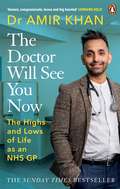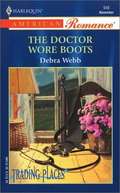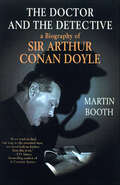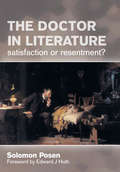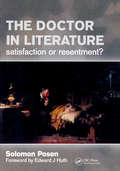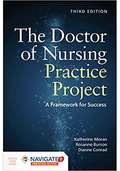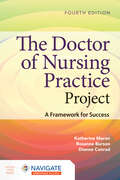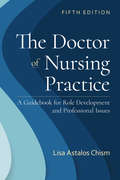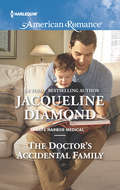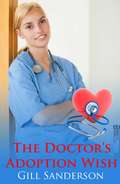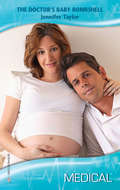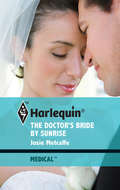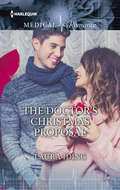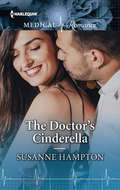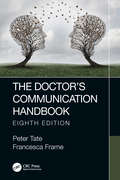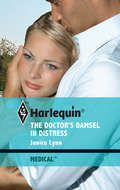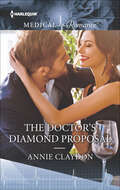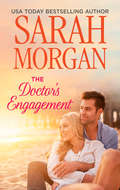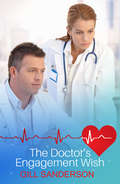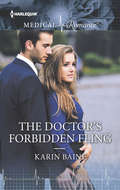- Table View
- List View
The Doctor Will See You Now: The highs and lows of my life as an NHS GP
by Amir Khan'Honest, compassionate, brave and big hearted' - LORRAINE KELLY'Celebrates human beings in all their glorious, messy imperfection' - CAT DEELEY Sunday Times Bestseller updated with a new chapter on Amir's experiences during the coronavirus pandemic and being on the frontlines of the historic vaccination effort.60 hours a week240 patients 10 minutes to make a diagnosis Welcome to the surgery. Charting his 15 years working as a GP, from rookie to becoming a partner in one of the UK's busiest surgeries, Dr Amir Khan's stories are as much about community and care as they are about blood tests and bodily fluids. Along the way, he introduces us to the patients that have taught him about love, loss and family - from the regulars to the rarities - giving him the most unbelievable highs and crushing lows, and often in just 10 minutes. There is the unsuspecting pregnant woman about to give birth at the surgery; the man offering to drop his trousers and take a urine sample there and then; the family who needs support through bereavement, the vulnerable child who will need continuing care for a long-term health condition; and, of course, the onset of COVID-19 that tested the surgery at every twist and turn. But, it's all in a day's work for Amir. The Doctor Will See You Now is a powerful story of hope, love and compassion, but it's also a rare insider account of what really goes on behind those surgery doors.
The Doctor Wore Boots
by Debra WebbTy Cooper had never been anything more than a big brother to Leanne Watley. Until he returned from his business trip. One look and pow! Leanne's heart couldn't stop pounding. One kiss and swoon! she was floored with desire.... Who was this man who claimed to be Ty Cooper? Dex Montgomery hadn't planned to fall in love. Especially not with his twin brother's beautiful neighbor. The sweetest young woman in Montana was a breath of fresh air to the big-city doctor. But Leanne thought she was falling for the man she was expected to marry. Could Dex stop himself before he lost his heart forever? Harlequin American Romance #948 Miniseries: Trading Places #2
The Doctor and the Detective: A Biography of Sir Arthur Conan Doyle
by Martin BoothA biography attempts to separate the life of the Edinburgh doctor from his fictional consulting detective from London.This entertaining, smart biography of Arthur Conan Doyle presents a modern-day interpretation of the man who, contrary to his best efforts, will always be known as the creator of the great detective, Sherlock Holmes. Doyle was, however, much more, as Booth shows us in this intriguing study of a man who thrived on the times in which he lived. While Holmes fans will be captivated by the various tidbits that offer insight into their hero’s creation; others will be fascinated by this living embodiment of the Victorian masculine ideal.Praise for The Doctor and the Detective“If we wish to find our way to the essential man, we need look no further than this work.” —P.D. James, bestselling author of A Certain Justice“An attractive and well-written introduction to Conan Doyle’s body of work.” —Library Journal“Readers who think of Conan Doyle only as the man who created Sherlock Holmes will be surprised, and perhaps even shocked, by this comprehensive and fascinating biography.” —Booklist
The Doctor and the Princess: The Doctor And The Princess Miracle For The Neurosurgeon Engaged To The Doctor Sheikh
by Scarlet WilsonHer very own Mr. Darcy As a rule, Gabrielle Cartier prefers the title "Dr." to "Princess." And when sexy surgeon Sullivan Darcy joins her humanitarian mission in the jungle, she's desperate to explore their chemistry. Until sudden news of her brother's abdication means Gabrielle must return home to rule! Sullivan longs to offer Gabrielle the support she needs but the pain of loss haunts him. Yet she stirs long-dormant feelings in him, feelings that give him the courage to confront his demons...and the determination to win his princess!
The Doctor in Literature, Volume 2: Private Life
by Solomon PosenFocusing on the personal lives of doctors, this annotated indexed anthology explores personality, behavior and doctor-patient relationships as portrayed in novels, short stories and plays. The Doctor in Literature, Volume 2 and its companion volume are unique among medical anthologies in that readers can look up medical topics as they appear in fiction. The choice of passages is based on clinical relevance, and the range of fully indexed subjects and quotations are generally not found in other texts. This work brings together an extraordinary array of passages from literature to provide a major reference source. It identifies and analyses recurring themes in the portrayal of medical doctors, and is sure to provide pleasure for readers who use it for browsing. Key reviews from The Doctor in Literature: satisfaction or resentment?
The Doctor in Literature: v. 1
by Solomon PosenMultiple-choice questions are an ideal way to improve understanding and revise for examinations. This book consists of 200 MCQs in psychiatry suitable for candidates for postgraduate examinations such as the MRCPsych. However medical students general practitioners psychiatric nurses clinical psychologists psychiatric social workers and psychiatric occupational therapists will also find it useful as a valuable revision guide. The questions have been carefully selected to reflect the educational needs of psychiatrists in training. Most questions are accompanied by a short answer to provide an ideal self-teaching book for all those wanting to revise for examinations and improve their understanding of this important area.
The Doctor of Nursing Practice Project: A Framework For Success
by Katherine J. Moran Dianne Conrad Rosanne BursonThe Doctor of Nursing Practice Project: A Framework for Success, Third Edition provides the foundation for the scholarly process enabling DNP students to work through their project in a more effective, efficient manner. The Third Edition is intended for practical application and remains focused on the scholarly project. In addition, it specifically outlines how the project has been used to prepare clinical scholars for practice, a focus seen nationally. A new chapter on health policy highlights the DNP core competencies that are used to advocate for healthcare policy change. This chapter covers how policy impacts practice, how the DNP nurse is the leader of the profession, their role as it relates to advocacy, the connection of the DNP project and health policy and concludes with an action plan. Coverage of the scholarly project tools and exemplars which highlight the variety of work by DNP nurses are also found throughout the text.
The Doctor of Nursing Practice Project: A Framework for Success
by Katherine J. Moran Dianne Conrad Rosanne BursonThe Doctor of Nursing Practice Project: A Framework for Success, Fourth Edition provides a road map and toolkit for students to use on their DNP scholarly project journey, starting from conception through completion and dissemination. With a focus on key information for planning, implementing, and evaluating a project, the text also emphasizes the impact that DNP-prepared nurses and well-developed DNP projects have in shaping the future of nursing and healthcare. The Fourth Edition has been thoroughly revised and updated to incorporate the new AACN Essentials and provides greater clarity on the current state of DNP project work. This practical resource features new content on sustainability, knowledge networks, sequential projects, the need for business acumen, financial analysis and implications, the need to work with stakeholders, as well as the need to use data to validate the problem.
The Doctor of Nursing Practice: A Guidebook for Role Development and Professional Issues
by Lisa Astalos ChismThe Doctor of Nursing Practice A Guidebook for Role Development and Professional Issues, Fifth Edition remains the most comprehensive guide for both role and career development for the DNP student and professional
The Doctor's Accidental Family
by Jacqueline DiamondAfter a disastrous relationship, Nurse Zady Moore just wants a family of her own and a guy with no baggage. With a young, vulnerable son, Dr. Nick Davis is exactly the kind of guy she should avoid.<P><P> But his offer is too good-free rent in exchange for occasional babysitting. And it comes at the right time, just as Zady's young goddaughter comes to stay with her. It's only for six months-surely she can resist Nick's charms. Nick likes Zady, and he enjoys the camaraderie of chasing after two little kids with her. But she works for his hated cousin, and with a battle brewing between departments at Safe Harbor Medical, can Nick trust that Zady's loyalties lie with him?
The Doctor's Adoption Wish
by Gill SandersonNurse Jane Hall is a wanderer. She is happy in her life in the Californian mountains until her brother-in-law Dr Cal Mitchell arrives with terrible news. Jane's sister and brother in law have both been killed in a car crash. They have left a three-year-old daughter, Helen. Cal wants to adopt Helen and needs Jane's permission. But Jane decides that she needs to be close to her now orphaned niece. She will come back to England with Cal and they can both try to make Helen happy. Cal isn't too happy with this but has to give way. Sharing the care for Helen works quite well. Cal and Jane grow closer to each other. But Cal has bitter memories of his own marriage. Is he ready to take a chance and ask Jane to marry him?
The Doctor's Adoption Wish: A Delightful Medical Romance (A Lakeland Practice series #1)
by Gill SandersonThe first novel in Gill Sanderson's heartwarming A Lakeland Practice series, perfect for fans of Mia Faye, Laura Scott, Helen Scott Taylor, Grey's Anatomy and ER.Readers LOVE Gill's enthralling medical romances!'Enjoyable and addictive read!' 5* reader review'Well written and keeps your interest' 5* reader review'What a truly wonderful teller of tales!' 5* reader review Nurse Jane Hall is a wanderer. She is happy in her life in the Californian mountains until her brother-in-law Dr Cal Mitchell arrives with terrible news. Jane's sister and brother in law have both been killed in a car crash. They have left a three-year-old daughter, Helen.Cal wants to adopt Helen and needs Jane's permission. But Jane decides that she needs to be close to her now orphaned niece. She will come back to England with Cal and they can both try to make Helen happy. Cal isn't too happy with this but has to give way.Sharing the care for Helen works quite well. Cal and Jane grow closer to each other. But Cal has bitter memories of his own marriage. Is he ready to take a chance and ask Jane to marry him?Don't miss Gill Sanderson's dreamy medical romances, including the Dell Owen and the Good, Bad and Ugly series.
The Doctor's Baby Bombshell
by Jennifer TaylorGorgeous doctor Ben Nicholls might be the heartthrob of Dalverston General, but he locked up his heart and threw away the key the day he watched Dr. Zoë Frost walk away from him. Two years later, when Zoë makes a fleeting visit back into town, the attraction between them is as irresistible as ever, and they spend one incredible night together. Zoë doesn't believe in happily-ever-afters, but what she does know for certain is that now she must face Ben and tell him she is pregnant with his baby.
The Doctor's Baby Surprise: A Charming Heartfelt Medical Romance (Good, Bad and Ugly #2)
by Gill SandersonThe second novel in Gill Sanderson's heartwarming Good, Bad and Ugly series, perfect for fans of Mia Faye, Laura Scott, Helen Scott Taylor, Grey's Anatomy and ER.Readers LOVE Gill's gripping medical romances!'Remarkable writer!!' 5* author review 'A truly wonderful writer' 5* author review 'I find all of Gill Sanderson's books very readable and enjoy the escapism they give me' 5* author review 'A truly gifted writer with an enormous amount of talent and sensitivity' 5* author review When playboy doctor Toby Sinclair discovers he has a son, he knew he had to face up to his responsibilities - but how? Knowing nothing about children, he turns to Dr Annie Arnold for help, even though he's behaved badly towards her in the past.Annie feels there is nothing left between them, but she can't refuse to help baby Charlie. Together, they begin to construct a life for the infant and she grows to love the child. Surprising even herself, she realises that she's also growing closer to Toby. After all they've been through, could they become the happy family she always dreamed of?Don't miss Gill Sanderson's enthralling medical romances, including the A Lakeland Practice and The Wilde Twins series.
The Doctor's Bride by Sunrise
by Josie MetcalfeAdam Donnelly has arrived at the Penhally Bay practice hoping to see more of his childhood sweetheart, paramedic Maggie Pascoe. Adam knows he's got a lot of explaining to do if he wants Maggie for his bride, but before they can even hope to resolve their past, the present intervenes in a dramatic way. . . . Some children have tumbled into in an old Cornish mine, and in the rescue attempt Maggie has become trapped herself. The only one who can save her is the man who once broke her heart. Now Adam has a final chance, and only a few short hours, to show Maggie that he's always loved her more than any other.
The Doctor's Christmas Proposal
by Laura IdingComing soon! The Doctor's Christmas Proposal by Laura Iding will be available Sep 12, 2016.
The Doctor's Cinderella: From Doctor To Princess? / The Doctor's Cinderella (Mills And Boon Medical Ser.)
by Susanne HamptonOne magical night……could change their lives forever!After her ex leaves her penniless, nurse Molly Murphy takes an admin job in doctor Ryan’s practice. When Ryan needs a date for a charity ball, Molly finds herself wearing a gorgeous gown and sipping champagne for one sparkling night. But her Prince Charming guards his emotions closely. Dare they trust what’s in their hearts to find their own fairy-tale ending?
The Doctor's Communication Handbook, 8th Edition
by Peter Tate Francesca FrameOf previous editions: '... breaks new ground in its readability … It is concise, wise, and firmly pragmatic'. British Medical Journal 'Since it was first published in 1994, Peter Tate’s The Doctor’s Communication Handbook has been essential reading to improve GP registrars’ communication skills'. Practical Diabetes International This bestselling title has established itself as the ultimate guide to patient communication for all doctors, whatever their experience and wherever they practice. Highly respected by many and acclaimed for its light, conversational tone, this completely updated and expanded eighth edition remains a key text for doctors at all levels and in all settings, particularly candidates sitting for the Membership of the Royal College of General Practitioners. Key Features Unique and accessible approach to this vital and frequently poorly practiced aspect of medicine Addresses the change in practice where traditional doctor consultations are increasingly being done by other health professionals, including nurse practitioners and paramedics Reflects the dissolution of the primary/secondary care boundary, and the increasing importance of shared responsibility for patient communication in clinical and social care Covers the new types of consultation including telephone triage and virtual consultation and the associated risks and benefits Retains all the features praised in previous editions − brevity, readability and humour As patients become participants, doctors are increasingly adjusting to new roles and forms of communication − from orators and governors to confidants and interpreters. The Doctor's Communication Handbook continues to provide an invaluable 'one stop shop' to help students, practicing doctors, nurses and other healthcare practitioners value and improve their skills in this area.
The Doctor's Damsel in Distress
by Janice LynnThere's something about Nurse Madison that has Dr. Levi Fielding desperate to have her in his arms. Her girl-next-door looks and unawakened sex appeal mean he can't resist flustering her. So when Levi saves Madison's life at a hospital picnic, he knows it's a white-knight moment he'll take full advantage of....
The Doctor's Destiny
by Meredith WebberNurse Alana Wright finds Dr. Rory Forrester strong medicine — he thinks he knows better than her how to run a hospital ward! And yet, she is incredibly attracted to him. But their war at work is nothing compared to Rory's private battle for custody of his nephew, Jason. Only marriage will improve his chances.While he and Alana might be colleagues in conflict, the chemistry between them is intense…and Jason and Alana get along great. Rory realizes he has found an angel who can answer his prayers and be his wife — but one thing stands in their way….
The Doctor's Diamond Proposal
by Annie ClaydonFalling for the celebrity doc Physiotherapist Alexandra Jackson never thought she'd see Leo Cross again after an accident changed her life. But when she's thrown back together with Leo she sees a hint of the boy she once met underneath the celebrity doctor's charming smile... Leo knows he can't give Alex the commitment she deserves-he's fighting too many demons of his own. But will their connection and Alex's positive approach to life inspire Leo to make her a proposal neither will ever forget?
The Doctor's Engagement
by Sarah MorganA fan-favorite medical romance from USA Today bestselling author Sarah Morgan. Holly knewthat she was possibly the only woman in Dr. Mark Logan's life who had never fallen headover heels in love with him! They had been best friends since childhood, so when he neededher to pretend to be his fiancée, she couldn't refuse… She hoped his gentle, protectivestrength would help her to get her life back on track again—but all it took was one singlebreath-taking kiss for Holly to discover that being Mark's fiancée was altogether a wholenew experience…! Originally published in 2001.
The Doctor's Engagement Wish: A Captivating Medical Romance (A Lakeland Practice series #3)
by Gill Sanderson<p>Doctor Erin Hunter had been the Golden Girl in school. She remembered Josh Harrison from those days, an amiable, athletic boy who ran in a different crowd from hers. Now they are G.P. Registrars together in Keldale, the village where she had been born. They are living in adjoining cottages and see a lot of each other. Cautiously, they get to know each other and fall in love.<p> <p>But Erin has a problem. Is she engaged to David King?<p> <p>He insists that she is, says that she agreed to marry him shortly before they had the appalling fall from Helvellyn that resulted in David having to have a leg amputated and and she losing her memory. Can Josh help her to find the truth?<p>
The Doctor's Fire Rescue
by Lilian DarcyComing soon! The Doctor's Fire Rescue by Lilian Darcy will be available Nov 1, 2016.
The Doctor's Forbidden Fling
by Karin BaineLady Violet's baby surprise! When a family illness calls nurse Violet Dempsey back to the aristocratic world she spurned years ago, she's finally forced to face Nate Taylor...the boy next door she left behind. Cardiologist Nate has come a long way from his life as the son of the hired help. Yet Violet's return shakes his foundations-and his resolve to ignore his lingering feelings for her! But after one forbidden night, everything changes. Now Violet and Nate find themselves facing an unexpected future...as a family of three!
